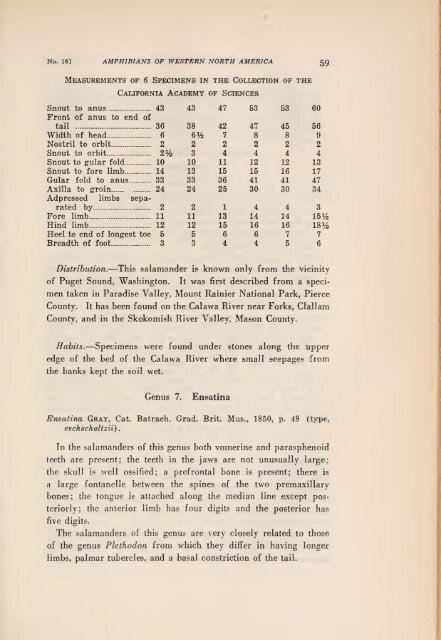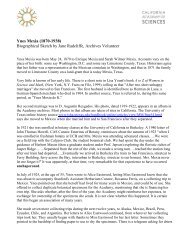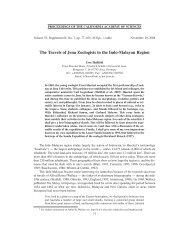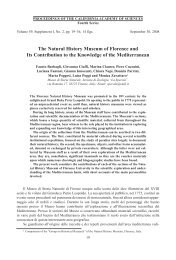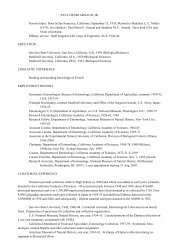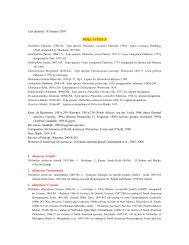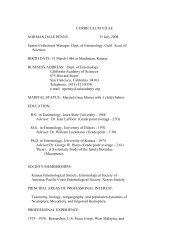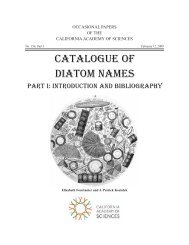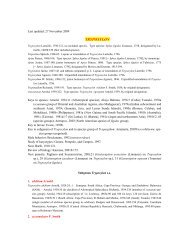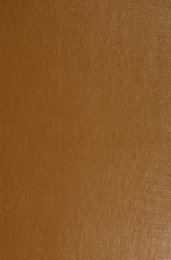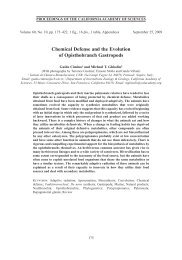PDF (9.91 MB) - Academy Research - California Academy of Sciences
PDF (9.91 MB) - Academy Research - California Academy of Sciences
PDF (9.91 MB) - Academy Research - California Academy of Sciences
You also want an ePaper? Increase the reach of your titles
YUMPU automatically turns print PDFs into web optimized ePapers that Google loves.
no. 16] amphibians <strong>of</strong> western north america 59<br />
Measurements <strong>of</strong> 6<br />
Specimens in the Collection <strong>of</strong> the<br />
Caufornia <strong>Academy</strong> <strong>of</strong> <strong>Sciences</strong><br />
Snout to anus 43 43 47 53 53 60<br />
Front <strong>of</strong> anus to end <strong>of</strong><br />
tail 36 38 42 47 45 56<br />
Width <strong>of</strong> head 6 6% 7 8 8 9<br />
Nostril to orbit 2 2 2 2 2 2<br />
Snout to orbit 2^^ 3 4 4 4 4<br />
Snout to gular fold 10 10 11 12 12 13<br />
Snout to fore limb 14 13 15 15 16 17<br />
Gular fold to anus 33 33 36 41 41 47<br />
Axilla to groin 24 24 25 30 30 34<br />
Adpressed limbs separated<br />
by 2 2 14 4 3<br />
Fore limb 11 11 13 14 14 15i^<br />
Hind limb 12 12 15 16 16 18y2<br />
Heel to end <strong>of</strong> longest toe 5 5 6 6 7 7<br />
Breadth <strong>of</strong> foot 3 3 4 4 5 6<br />
Distribution.— This salamander is<br />
known only from the vicinity<br />
<strong>of</strong> Puget Sound, Washington.<br />
It was first described from a specimen<br />
taken in Paradise Valley, Mount Rainier National Park, Pierce<br />
County.<br />
It has been found on the Calawa River near Forks, Clallam<br />
County, and in the Skokomish River Valley, Mason County.<br />
Habits.— Specimens were found under stones along the upper<br />
edge <strong>of</strong> the bed <strong>of</strong> the Calawa River where small seepages from<br />
the banks kept the soil<br />
wet.<br />
Genus 7.<br />
Ensatina<br />
Ensatina Gray, Cat. Batrach. Grad. Brit. Mus., 1850, p. 48 (type,<br />
eschscholtzii) .<br />
In the salamanders <strong>of</strong> this genus both vomerine and parasphenoid<br />
teeth are present; the teeth in the jaws are not unusually large;<br />
the skull is well ossified; a prefrontal bone is present;<br />
there is<br />
a large fontanelle between the spines <strong>of</strong> the two premaxillary<br />
bones; the tongue is attached along the median line except posteriorly;<br />
the anterior limb has four digits and the posterior has<br />
five digits.<br />
The salamanders <strong>of</strong> this genus are very closely related to those<br />
<strong>of</strong> the genus Plethodon from which they differ in having longer<br />
limbs, palmar tubercles, and a basal constriction <strong>of</strong> the tail.


